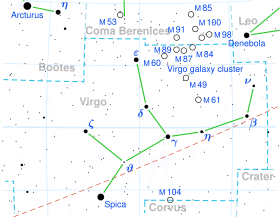
| |
| Observation data Epoch J2000 Equinox J2000 | |
|---|---|
| Constellation | Virgo |
| Right ascension | 14 28 12.13894 |
| Declination | −02° 13′ 40.6579″ |
| Apparent magnitude (V) | +4.81 |
| Characteristics | |
| Spectral type | G2 IV |
| B−V color index | +0.683 |
| Astrometry | |
| Radial velocity (Rv) | −9.88±0.15 km/s |
| Proper motion (μ) | RA: −139.53 mas/yr Dec.: −4.04 mas/yr |
| Parallax (π) | 27.58 ± 1.01 mas |
| Distance | 118 ± 4 ly (36 ± 1 pc) |
| Absolute magnitude (MV) | 1.68 |
| Details | |
| Mass | 1.80 M☉ |
| Radius | 4 R☉ |
| Luminosity | 12.6 L☉ |
| Surface gravity (log g) | 3.4 cgs |
| Temperature | 5,534 K |
| Metallicity | −0.06 dex |
| Rotational velocity (v sin i) | 15.5 km/s |
| Age | 1.5 Gyr |
| Other designations | |
| Elgafar, φ Vir, 105 Virginis, BD−01°2957, FK5 533, GJ 550.2, HD 126868, HIP 70755, HR 5409, SAO 139951 | |
| Database references | |
| SIMBAD | data |
Phi Virginis (φ Virginis, abbreviated Phi Vir, φ Vir) is a binary star in the zodiac constellation of Virgo. It can be seen with the naked eye, having an apparent visual magnitude of +4.81. Based upon parallax measurements obtained during the Hipparcos mission, it is located roughly 118 light-years (36 parsecs) distant from the Sun.
The two components are designated Phi Virginis A (officially named Elgafar /ˈɛlɡəfɑːr/, the traditional name for the system) and B.
Nomenclature
φ Virginis (Latinised to Phi Virginis) is the binary's Bayer designation. The designations of the two components as Phi Virginis A and B derive from the convention used by the Washington Multiplicity Catalog (WMC) for multiple star systems, and adopted by the International Astronomical Union (IAU).
Ideler described an Arabic lunar mansion "El-ġafr" (Arabic الغفر al-ghafr) for the stars Phi, Iota and Kappa Virginis. In 2016, the IAU organized a Working Group on Star Names (WGSN) to catalog and standardize proper names for stars. The WGSN decided to attribute proper names to individual stars rather than entire multiple systems. It approved the name Elgafar for the component Phi Virginis A on 1 June 2018 and it is now so included in the List of IAU-approved Star Names.
In Chinese, 亢宿 (Kàng Xiù), meaning Neck, refers to an asterism consisting of Phi Virginis, Kappa Virginis, Iota Virginis, and Lambda Virginis. Consequently, Phi Virginis itself is known as 亢宿三 (Wěi Xiù sān), "the Third Star of Neck".
Properties
The primary component, Phi Virginis A, has a stellar classification of G2 IV, indicating that it is a G-type subgiant which is evolving away from the main sequence. It is slightly variable with an amplitude of 0.06. The star has about 1.8 times the mass of the Sun, 4 times the Sun's radius, and shines with 12.6 times the luminosity of the Sun. It is around 1.5 billion years old and is spinning with a projected rotational velocity of 15.5 km/s. The effective temperature of the star's outer atmosphere is 5,534 K.
The secondary, Phi Virginis B, is a magnitude 9.10 companion at an angular separation of 5.160 arcseconds. A second visual companion lies at an angular separation of 91.40 arcseconds along a position angle of 202°, as of 2000.
The system is a source of X-ray emission with a luminosity of 2.158×10 erg/s.
References
- ^ van Leeuwen, F. (November 2007), "Validation of the new Hipparcos reduction", Astronomy and Astrophysics, 474 (2): 653–664, arXiv:0708.1752, Bibcode:2007A&A...474..653V, doi:10.1051/0004-6361:20078357, S2CID 18759600.
- ^ Gray, R. O.; et al. (2001), "The Physical Basis of Luminosity Classification in the Late A-, F-, and Early G-Type Stars. I. Precise Spectral Types for 372 Stars", The Astronomical Journal, 121 (4): 2148–2158, Bibcode:2001AJ....121.2148G, doi:10.1086/319956, S2CID 117076031.
- ^ Massarotti, Alessandro; et al. (January 2008), "Rotational and radial velocities for a sample of 761 HIPPARCOS giants and the role of binarity", The Astronomical Journal, 135 (1): 209–231, Bibcode:2008AJ....135..209M, doi:10.1088/0004-6256/135/1/209.
- Schiavon, Ricardo P. (July 2007), "Population Synthesis in the Blue. IV. Accurate Model Predictions for Lick Indices and UBV Colors in Single Stellar Populations", The Astrophysical Journal Supplement Series, 171 (1): 146–205, arXiv:astro-ph/0611464, Bibcode:2007ApJS..171..146S, doi:10.1086/511753, S2CID 13946698.
- ^ Mallik, Sushma V.; Parthasarathy, M.; Pati, A. K. (October 2003), "Lithium and rotation in F and G dwarfs and subgiants", Astronomy and Astrophysics, 409 (1): 251–261, Bibcode:2003A&A...409..251M, doi:10.1051/0004-6361:20031084.
- "* phi Vir". SIMBAD. Centre de données astronomiques de Strasbourg. Retrieved 2016-09-18.
- ^ Eggleton, P. P.; Tokovinin, A. A. (September 2008), "A catalogue of multiplicity among bright stellar systems", Monthly Notices of the Royal Astronomical Society, 389 (2): 869–879, arXiv:0806.2878, Bibcode:2008MNRAS.389..869E, doi:10.1111/j.1365-2966.2008.13596.x, S2CID 14878976.
- ^ "Naming Stars". IAU.org. Retrieved 18 June 2018.
- Hessman, F. V.; Dhillon, V. S.; Winget, D. E.; Schreiber, M. R.; Horne, K.; Marsh, T. R.; Guenther, E.; Schwope, A.; Heber, U. (2010). "On the naming convention used for multiple star systems and extrasolar planets". arXiv:1012.0707 .
- Ideler, Ludwig (1809). Untersuchungen über den Ursprung und die Bedentung der Sternnamen. J. F. Weiss.
- "IAU Working Group on Star Names (WGSN)". Retrieved 22 May 2016.
- "WG Triennial Report (2015-2018) - Star Names" (PDF). p. 5. Retrieved 2018-07-14.
- (in Chinese) 中國星座神話, written by 陳久金. Published by 台灣書房出版有限公司, 2005, ISBN 978-986-7332-25-7.
- (in Chinese) 香港太空館 - 研究資源 - 亮星中英對照表 Archived 2008-10-25 at the Wayback Machine, Hong Kong Space Museum. Accessed on line November 23, 2010.
- Adelman, S. J.; et al. (December 2000), "On the Variability of G0-G9 Stars", Information Bulletin on Variable Stars, 4993: 1, Bibcode:2000IBVS.4993....1A.
- Mason, B. D.; et al. (2014), "The Washington Visual Double Star Catalog", The Astronomical Journal, 122 (6): 3466–3471, Bibcode:2001AJ....122.3466M, doi:10.1086/323920, retrieved 2015-07-22.
- Makarov, Valeri V. (October 2003), "The 100 Brightest X-Ray Stars within 50 Parsecs of the Sun", The Astronomical Journal, 126 (4): 1996–2008, Bibcode:2003AJ....126.1996M, doi:10.1086/378164.